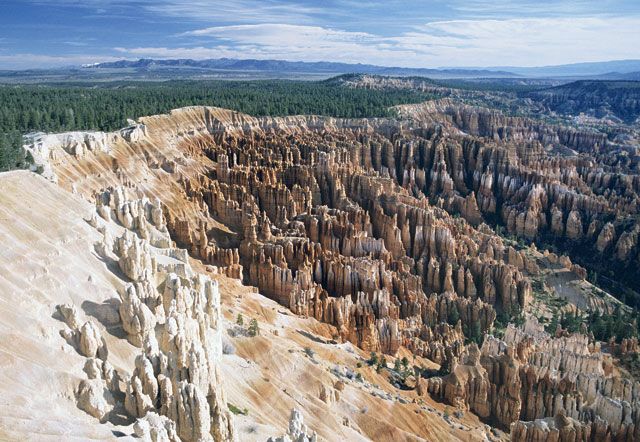Night falls quickly in Arizona. Once the Sun has slipped behind the vast ridges that edge the skyline, the sprawling desert turns mauve, then deep purple, then suddenly treacle-black. Driving out of the small town of Page into a darkening void, it struck me that these were not the ideal conditions for finding our hotel — the unsigned, unannounced Amangiri, somewhere beyond the rocky outcrops and the silent, towering buttes, almost wilfully, elusive.
It's a classic Aman trait, of course. Adrian Zecha's chain of hotels may have grown to 24 since he started in Thailand in 1988 but their profile remains deliberately low. Even so, they are successful: Zecha's trademark luxy minimalism now even has its own breed of clientele. "Amanjunkies" are the wearied wealthy, who tailor their holidays around locations with an Aman hotel. And they have been counting the days to the opening late last month of this, only the second Aman in North America.
Looks are deceptive
Fortunately, we did have written directions and three miles (and an hour's time change) over the border into Utah. We turned left up a gravel track. After a mile, I spied an intercom by a rusty gate. "That will be it," I said to my friend, Ali, who looked up from her map and snorted.
But a cheery voice bade us welcome through the intercom, the gate swung open and we glided on through the darkness for another mile before drawing up at a low building edged with wide steps lined with candles. Around it lay desert and darkness.
At first sight, the location for Amangiri seems surprising: in empty desert, with only the unprepossessing town of Page for company. But Zecha is a canny operator. These sprawling expanses hold some of the most stunning landscapes on the planet — Amangiri is within driving distance of the Grand Canyon, Monument Valley and the Bryce and Zion canyons. It is ten minutes from Lake Powell, a canyon that was dammed to become a reservoir and is now the US's second-biggest lake.
Class is what the Aman is all about. The aim is to combine a relaxed, home-from-home feel with faultless service. Informality is key: At Amangiri, there is no separate restaurant, no lounge and no lobby. One glass-walled rectangular building holds them all in a single open-plan space — sofas by roaring fires on one side, dining tables on the other, a lounging space full of games and magazines in between. Staff in muted-green polo shirts stroll around, waiting to be asked for lunch or, possibly, a game of Scrabble.
Architecturally, it's a masterpiece. It was designed by a local firm and the sharp angles and minimalist styling manage to avoid the froideur this type of building exudes.
Fascinating views
Perhaps it's because the right angles and dramatic lines have been placed in such a way as to allow glimpses of the sunwashed landscapes. Or perhaps it's the fact that the hotel really does blend right into the surroundings: Beyond our room lay a small seating space with a fire; beyond that lay empty scrub and rock. There was no boundary, no fence — just a single footfall between hotel and desert. We drove through the high plateau of Navajo Nation, the US's biggest Indian reservation, with some 200,000 residents, to Monument Valley, where we stared spellbound as the Sun set behind the rock buttes.
We spent a blissful day on Lake Powell, pausing to walk up to Rainbow Bridge, the oldest national monument in the US, where Shannon, a Navajo ranger, gave us an insight into her world — an older, more mystical existence than the America most of us today recognise.
This is the other, less expected, advantage of Amangiri's location: the chance to explore Native American culture. An interactive museum was recently opened in Tuba City in the heart of Navajo Nation but I was struck by the Museum of Northern Arizona in Flagstaff, originally a repository for Native American artefacts, where displays on various Indian tribes and the fates that befell them made for sobering reading.
Small-town America
What the hotel lacks is a sense of place. One evening we drove to Page, a classic Nowheresville built in the 1950s to house workers on the Glen Canyon Dam. The main street was fringed with car parks, supermarkets and fast-food joints. We enjoyed refreshments at the Dam Bar, where four basketball games played out on screens above the optics, and ate a truly dreadful Mexican meal but drove back strangely elated. We were in small-town America and, for that evening, it felt like it.
Amangiri won't suit everyone, particularly those on a budget. It is wallet-searingly expensive — better for a couple of nights' escape from a motel-filled road trip than a week's stay. The room rates are high enough but then there are the extras. Guided desert hike: $250 (Dh918). Buffet breakfast for two: $80 (Dh294). A massage in the Zen-tastic spa: $150 (Dh551).
"We don't believe in asking guests to sign for bills," said Sunny, when I mentioned the quizzical look on the waiter's face when I had asked for the cheque the previous evening.
"How do you know what you have spent," asked a bemused Ali, as we prepared to check out. "Or that it's right?"
Good question: Two identical buffet breakfasts came in at a different price each day. As was perhaps expected, I didn't query it. At Amangiri, if you have to ask the price, you definitely can't afford it.



